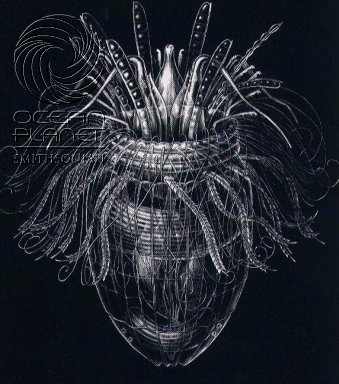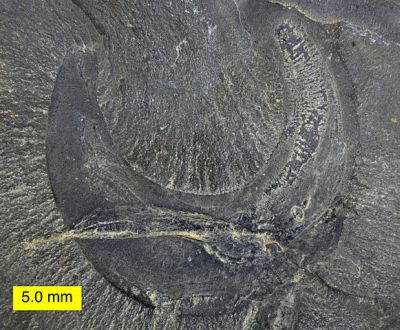 Pliciloricus enigmatus Higgins & Kristensen, 1986 (Loricifera, Nanaloricida, Pliciloricidae). Actual size is about one-quarter of a millimeter.,
Pliciloricus enigmatus Higgins & Kristensen, 1986 (Loricifera, Nanaloricida, Pliciloricidae). Actual size is about one-quarter of a millimeter.,EM image from nasa.gov via wiki.en Wikimedia Commons. Public domain
| Scalidophora | ||
| Scalidophora | Scalidophora |
| Ecdysozoa | Protostoma
└─Ecdysozoa
└─► |
Palaeoscolecida | ||
| Ecdysozoa | Nematoida |
|
Abbreviated Dendrogram
Bilateria
├─Deuterostomia
└─┬─Spiralia
│
└─Ecdysozoa = paraphyletic Scalidophora?
├─Markuelia
├─Kinorhyncha
╞═Palaeoscolecida
╞═Priapozoa
│ └─┬─Priapulida
│ └─┬─Sirilorica
│ └─Loricifera
└─┬─Nematoida
└─Panarthropoda
|
Contents
Overview |
 Pliciloricus enigmatus Higgins & Kristensen, 1986 (Loricifera, Nanaloricida, Pliciloricidae). Actual size is about one-quarter of a millimeter.,
Pliciloricus enigmatus Higgins & Kristensen, 1986 (Loricifera, Nanaloricida, Pliciloricidae). Actual size is about one-quarter of a millimeter.,EM image from nasa.gov via wiki.en Wikimedia Commons. Public domain |
The Scalidophora are a group of marine pseudocoelomates (animals lacking a true body cavity), consisting of the three phyla Kinorhyncha, Priapulida, and Loricifera. The members of this group share a number of characteristics, including introvert larvae and moulting of the cuticle (ecdysis). Kinorhyncha and Loricifera are both minute meiofaunal predators, while Priapulida can reach (for a worm) reasonably large sizes. They were originally included in the phylum Aschelminthes, along with other taxa now placed in the Lophotrochozoa, which is now known to be a polyphyletic taxon. They are now considered to either constitute one of the two or three clades of the Ecdysozoan superphylum, or to be a paraphyletic assemblage of generalised Ecdysozoans, from which more specialised lineages like the Panarthropoda (which may themselves be paraphyletic or ancestral, although we have here more parsimoniously treated them as monophyletic) are derived. Wikipedia, updated MAK120420
 Ottoia prolifica from the Walcott Quarry of the Burgess Shale (Middle Cambrian) near Field, British Columbia, Canada.
Ottoia prolifica from the Walcott Quarry of the Burgess Shale (Middle Cambrian) near Field, British Columbia, Canada. Photo by Mark A. Wilson, Wikipedia, public domain |
Scalidophora have a fairly extensive fossil record for a soft-bodied clade, particularly in the Cambrian. Indeed, scalidophorans seem to have been the major infaunal predators in the Cambrian fauna, only later being replaced by the annelids. While fossil scalidophorans such as Palaeoscolex and Ottoia are often referred to as priapulids, most of them lie outside the priapulid crown group and may not have exactly resembled modern species. The name Priapulida is better retained for the crown group, with Priapozoa used for the wider group including the Cambrian taxa.
Palaeoscolex and its close relatives were covered in an armour of small plates, and disarticulated plates are commonly found as microfossils. The Palaeoscolecida were regarded as probable annelids for many years, until Conway Morris reidentified them as priapulid relatives. CKT061014
 Anatomy of a stylised scalidophoran. ca - caudal appendages; cg - caudal "ganglion"; gn - gonad; gt - well, in - central part of an introvert; ir - introvert retractor; mc - mouth cone; ng - neck ganglion; nk - neck; os - oral stylet (arming) pn - cluster of protonephridia (left side: vinctiplicatan variant, right: kinorhynch) rb - ring-brain, sc - scalids; tk - in trunk; vn - ventral nerve cord. Diagram by Kuzia from Wikipedia, GNU Free Documentation/Creative Commons Attribution Share Alike |
Scalidophora (= Cephalorhyncha) Markuelia
Fr ECambrian
Phylogeny: Ecdysozoa : Panarthropoda + Nematoida + * : Markuelia + Palaeoscolecida (paraphyletic) + (Kinorhyncha + (Loricifera + Priapulida)
Comments: The Scalidophora is based on shared details of the introvert in priapulids, kinorhynchs and loriciferans (Edgecombe et al 2011). This grouping has been recovered as monophyletic by molecular studies (Halanych 2004). Nielsen (2001) used the name Cephalorhyncha for this clade (see also (UCMP) link, below), but in its original usage it also included the Nematomorpha. Based on new molecular data and analyses, Sørensen et al. (2008) concluded that the Loricifera and Nematomorpha appear to be sister taxa, which would make the Scalidophora (or Cephalorhyncha sensu Nielsen 2001) clade paraphyletic. Conversely some paleontological morphological analysis locates them between the Kinorhyncha and Priapulida (Dong et al 2004 and later papers, e.g. Dong et al 2005 and Harvey et al 2010). The implication is that either the moloceular or the morphological characters are convergent. For now we have followed the latter, pending further analyses
As of 2010, relationships among phyla within the Ecdysozoa remain poorly resolved, so it is difficult to know which groups will eventually win wide acceptance by specialists as convincingly monophyletic and deserving of a name. - Leo Shapiro, EoL EoL (Attribution-NonCommercial-ShareAlike); MAK120415
For now, we have followed the traditional phylogeny (based on molecular studies). However, it may be that the priapulida (or, more correctly, the priapozoa) are primitive, and that kinorhynchs and loriciferans represent more derived ancestors, with the kinorhynchs being the most specialised, rather than the most basal, of all. The apparently basal position of these miniaturised forms would be due to their highly derived nature, and loss of traditional synapomorphies. Or it may be that the priapulids sensu latu are a paraphyletic assemblage, with some Cambrian priapulids (or priapozoa), such as Ancalagon and Fieldia, occupying a basal position, near Markuelia (Dong et al 2004, cladogram, fig 3b; Dong et al 2005 cladogram, fig 3a.) MAK120420
Link: Introduction to the Cephalorhyncha (UCMP)
Image scalidophoran external and internal structures, by Kuzia by-sa 3.0 / gnu Wikipedia

Cambrian
Phylogeny: Basal Scalidophora
Comments: Known only from fossil embryos. Wikipedia: X-ray tomographic microscopy has been applied to splendidly preserved, uncrushed Markuelia fossils found in Hunan province in southern China and in eastern Siberia. When details in features smaller than one micrometre across can be observed, these fossils are seen to represent many developmental stages, from the first cell divisions to the time of hatching; therefore they offer a unique opportunity to study the development of Early Cambrian animals.
Image Reconstruction of the embryo of Markuelia hunanensis unfurled, Dong et al 2004 fig 3a. This species is from the Late Cambrian Bitiao Formation in Wangcun, Hunan, south China; the earliest record of the genus is Early Tommotian (earliest Cambrian) (Dong et al 2004 p.239)
| Ecdysozoa | Palaeoscolecida |
page MAK120419. All original text content by M. Alan Kazlev Creative Commons Attribution . Other content copyright respective authors or publishers